The EVGA GeForce GTX 1070 Ti FTW2 Review: iCX Brings the Lights and Sensors
by Nate Oh on January 31, 2018 9:00 AM EST- Posted in
- GPUs
- EVGA
- GeForce
- NVIDIA
- GTX 1070 Ti
Overclocking
Ultimately, the EVGA GTX 1070 Ti FTW2 is being pushed as an overclocking card, like the reference Founders Edition. The importance is clear for custom boards that may only run at reference clocks. To note, while NVIDIA does support overclocking, they have limited actual overvolting, and instead providing the ability to unlock 1-2 more boost bins and associated voltage points. In Precision XOC, this features as the percent voltage boost slider.
Precision XOC is already needed to fully utilize all iCX features, and by using it we were able to gauge the ‘software overclocking’ angle of the GTX 1070 Ti FTW2. In concrete numbers, running the Short Test resulted in offsets around +80 to +115MHz to the core clock, while running the Long Test resulted in a voltage curve with a maximum offset of +125MHz. The Long Tests occasionally crashed the ScannerX window, requiring user intervention to move on. One of the Short Tests applied a +114MHz offset, which we benchmarked. As neither OC test changes the power and temperature limits, the pseudo-overvoltage percentage boost, or even the maximum tested offset of +150MHz, we also benchmarked a manual overclock of +200MHz core and +200MHz memory offsets, with 120% power limit, 83 degree temperature target, and maximum voltage boost.
| EVGA GeForce GTX 1070 Ti FTW2 Overclocking | |||||
| Stock | Short Test Overclock | Manual Overclock | |||
| Core Clock | 1607MHz | 1721MHz | 1807MHz | ||
| Boost Clock | 1683MHz | 1797MHz | 1883MHz | ||
| Max Boost Clock | 1898MHz | 2012MHz | 2098MHz | ||
| Memory Clock | 8Gbps | 8Gbps | 8.8Gbps | ||
| Max Voltage | 1.062v | 1.062v | 1.093v | ||
| Power Limit | 180W | 180W | 217W | ||
Even that configuration does not represent the fullest mainstream overclocking capabilities of the GTX 1070 Ti FTW2. The maximum 235W power draw can only be accessed with a 130% power limit setting, something that is not available under the standard (master) BIOS. In any case, without knowing beforehand about EVGA Double BIOS on Pascal cards, it’s likely that a user will not understand that the maximum 235W power draw specification needs to be enabled.
In the case of the GTX 1070 Ti FTW2, toggling to the secondary (slave) BIOS raises the power limit to 130%, raises the temperature target to 93 degrees, applies a more aggressive fan curve, and disables zero fan speed idle. As EVGA notes, the Pascal architecture will reduce clockspeeds once the GPU core temperature reaches 60 degrees, so for the maximum mainstream overclock a very aggressive fan curve should be applied. For the curious, we were able to reach past 2100MHz by using the slave BIOS.
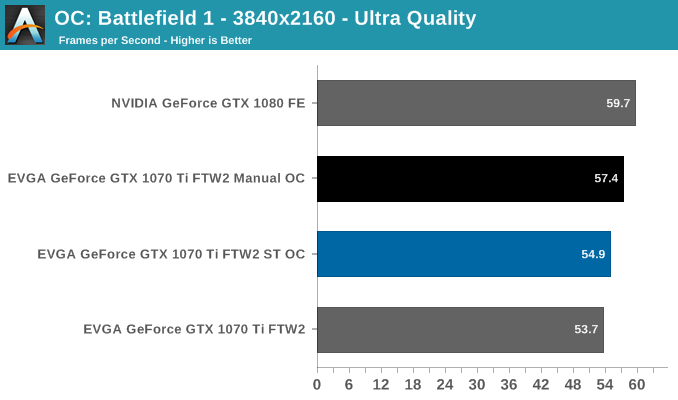
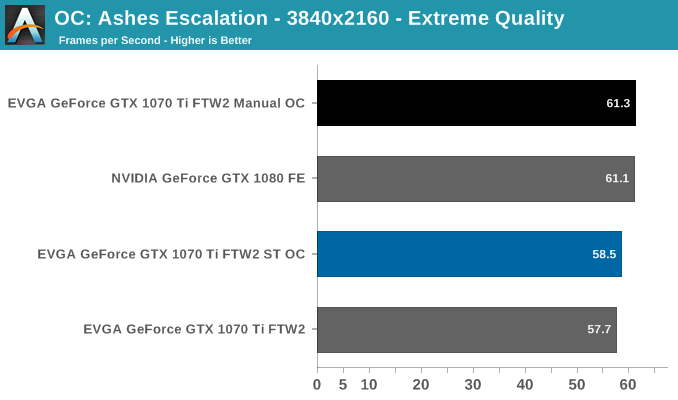
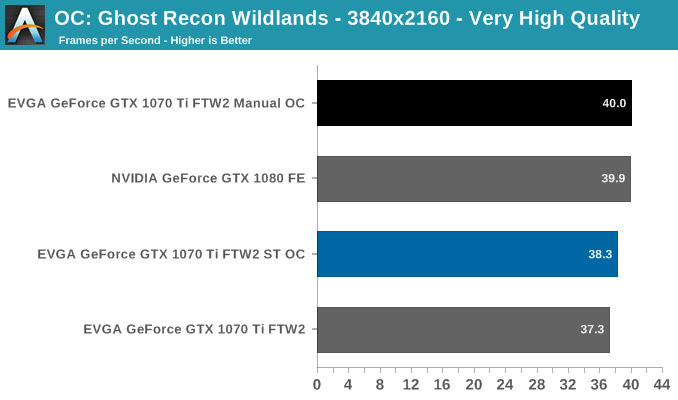
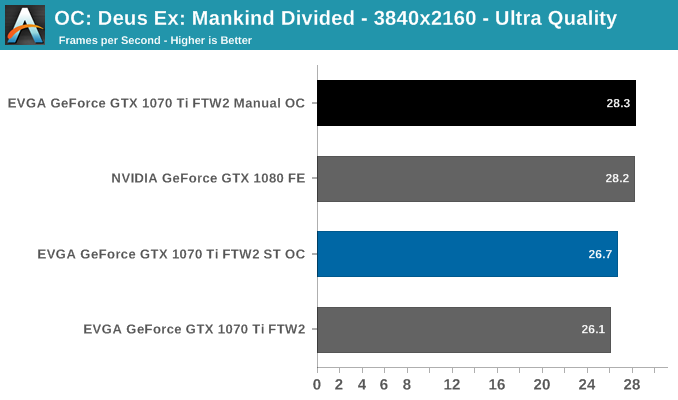
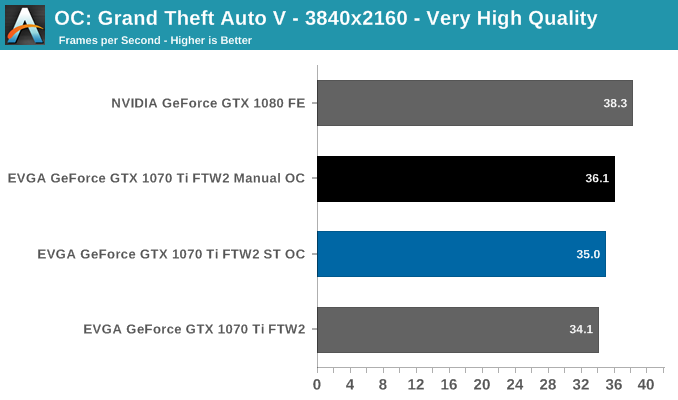
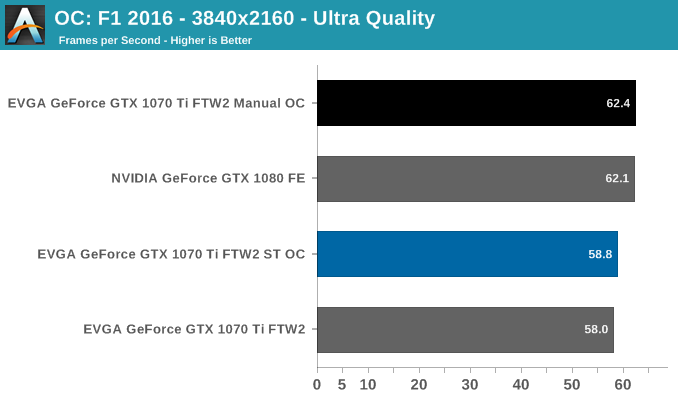

As always with overclocking, individual GPU dies behave differently and a sample size of one is not representative of all models. Nevertheless, the performance increases are in line to what we saw with overclocking the GTX 1070 Ti Founders Edition. The capability to perform at the level of a GTX 1080 definitely exists. And as a case study of EVGA’s new-ish single-step overclocking solution, we can see that Precision XOC applies a mild overclock that can be accomplished without relatively riskier changes to power/temperature limit or voltage boost. This carries through to the power, temperature, and noise aspects, which are equally as tame as the Short Test overclock.
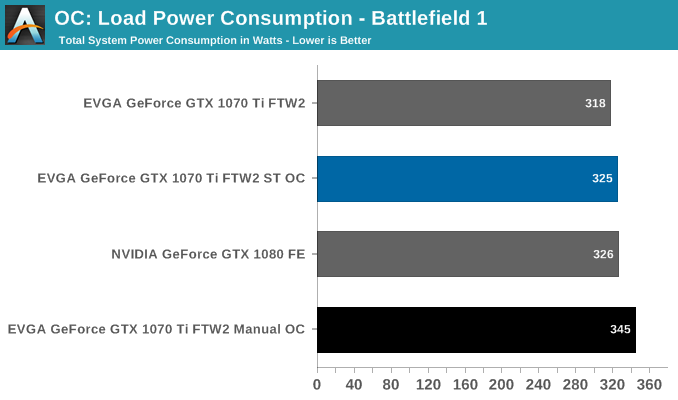
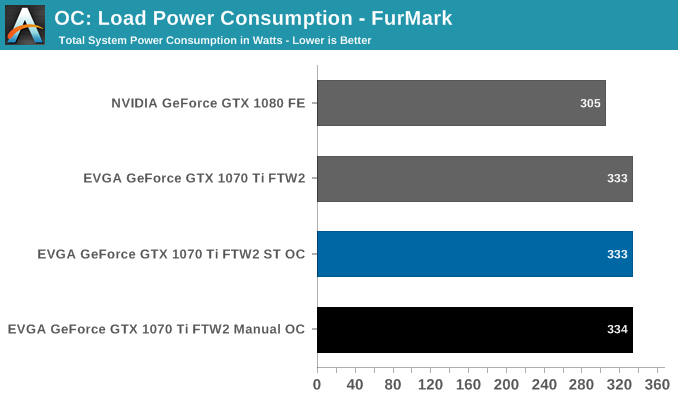
That being said, our XOC Scanner auto-overclocks act better as a selling point than a perceptible performance increase; in our results, framerates increased by an average of 2%. Now, it is true that a good amount of factory overclocked graphics card have only token clockspeed increases, if only just to say that it’s overclocked, something that is not possible for the GTX 1070 Ti series. Even if higher software-enabled clockspeeds are advertised, the software itself is more-or-less optional. Whereas, independent from overclocking, the GTX 1070 Ti FTW2 iCX needs Precision XOC to truly – and literally, for that matter – shine. So in that sense XOC Scanner nonetheless provides the GTX 1070 Ti FTW2 iCX the closest thing to a common factory-esque overclock than its peers.










47 Comments
View All Comments
Dr. Swag - Wednesday, January 31, 2018 - link
Fury x always was faster than a 980DnaAngel - Tuesday, May 22, 2018 - link
Heck my old R9 390 would match or outperform the 980 in a good amount of titles. Which was always comical, as the 390 was supposed to compete with the 970, which it did at launch with launch drivers, but after a few months of driver improvements, it was going toe to toe with not the 970, but the 980 lol.masouth - Wednesday, January 31, 2018 - link
Either I'm just missing your sarcasm or you are dredging up 2.5 year old GPU news regarding the Fury X being faster than a GPU released 9 months before it while simultaneously ignoring that the GTX 980ti which was released 2 weeks before the Fury X was faster than the Fury X?Sounds like another day in the world of GPUs. Anybody that thinks buying the top tier is going to stay there for much more than 6-12 months either caught the market at the absolute perfect time or is basically delusional.
masouth - Wednesday, January 31, 2018 - link
and yes I realize you are commenting on the charts but how data ends up on charts seems like old news as well.Makaveli - Wednesday, January 31, 2018 - link
So winning by 3-5 fps in a game is destroying now??nice troll bait.
CiccioB - Thursday, February 1, 2018 - link
You made my day... comparing the Fury X with the 980 to signa point... wait.. the new flagship Vega64 is faster than the 1050Ti!!!!!!!!!Yes, all 1050Ti owners are crying out for that result!
AMD fanboys can really become ridiculous
BurntMyBacon - Thursday, February 1, 2018 - link
I completely agree that the Fury X vs 980 is a bad comparison and I have no intention of defending what should not be defended.Regarding ridiculousness however, the 980 is a single SKU below the proper competition (980Ti) and still in the same high end classification. While not the case here, there have often in the past been price disparities between the top end SKUs from ATi and nVidia that warrant such a comparison.
1080Ti > 1080 > 1070Ti > 1070 > 1060 > 1050Ti
N/A > Vega64 > Vega56 > N/A > 580 > 570
On the other hand, your Vega64 vs 1050Ti comparison is pitting AMDs top GPU against a card 5 SKUs below nVidia's top GPU (4 SKUs below the proper competition) and classified lower mid range at best. Then you proceed to suggest these comparisons are somehow similar and label IGTrading as a "ridiculous" AMD fanboy. IGTrading's comparison was certainly the wrong comparison, but who's more deserving of the "ridiculous fanboy" label?
DnaAngel - Tuesday, May 22, 2018 - link
That analogy doesn't really work. Maybe in 4K, but only a small fraction of users are at 4K right now. The majority are in 1080/1440p and at those resolutions, the 1070Ti is not only trading blows, but sometimes outperforming not the Vega 56 it was meant to compete against, but the 800 dollar Vega 64.Jad77 - Wednesday, January 31, 2018 - link
...the Lights and Sensors and the weirdest graphics card cosmetics I've ever seen. Why didn't EVGA use the new 1080 ti shrouds? Whatever, I've gone without Pascal this long I'm waiting for Volta.Gunbuster - Wednesday, January 31, 2018 - link
I'm confused on that as well. It's got a half-hearted Tron sorta thing going on with the light diffusers, but then has the steampunk rivet looking screw things, then the dollar store electronics looking badges laid over and blocking two of the lights...